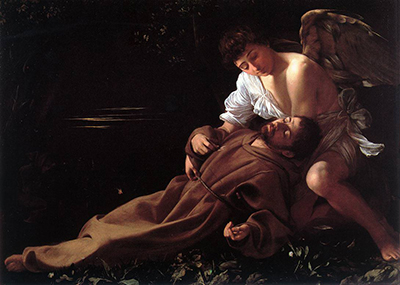In 1595, during the most definitive stage of his career, Caravaggio painted St Francis of Assisi in Ecstasy.
In the painting, St Francis reclines in the arms of a winged angel. The eyes of the saint are closed and the look of intensity upon his face suggests that he is experiencing deep emotion or ecstasy.
Despite the presence of the angel, the bed of verdure underneath the saint indicates that he is not in heaven, but very firmly upon earth.
The figures are lit by an unidentified source of brightness, cast upon the face and hands of St. Francis and throwing one half of the body and face of the angel into shadow.
Together with the ripples on the pond and the faint but definite floral outlines in the background, this use of light emphasizes the physicality of the scene while imbuing it with a spiritual glow. The technique and subject matter are typical of paintings by the artist Michelangelo Merisi da Caravaggio (c.1571-1610).
Caravaggio was born in Milan, studied art with Simone Peterzano and by the 1590’s, had begun painting the religious and allegorical works that made his name. Today, his paintings are characterised by tenebrism, a colouring technique, and the intense and often unearthly emotion that his subjects experience in realist surroundings.
Much has been written about Caravaggio’s irascible personality and the 1606 brawl that forced him to turn fugitive following a man's death. Caravaggio undoubtedly channeled personal intensity into his works, but the religious ethos of late sixteenth-century Italy also accounts for his subject matter. The Council of Trent (1545-1563) gave rise to the Counter-Reformation, a resurgence of Catholic values in a world where the Protestant Reformation had lately defined religion. This new consciousness resulted in a widening market for subjects conveying intense religiosity to patrons of art.
With his ability to produce subjects in ecstasy, prayer and penitence, for example, Penitent Magdalene (1594-95), Caravaggio was able to meet this market. Evident in this painting and in St Francis of Assisi in Ecstasy is tenebrism, which means “darkness”.
By the late 1500’s, the bright colours of the earlier Renaissance painters had given way to a more limited, earthen palette. Caravaggio and other artists became adept at creating mood, atmosphere and the illusion of light by subtly blending a range of reds and browns, oranges and yellows.
The light illusion is significant because it accounts for the almost spiritual glow that we see in St Francis of Assisi in Ecstasy. It is evident also in Caravaggio’s paintings Supper at Emmaus (1601) and The Taking of Christ (1602), and is prescient of the works of Rembrandt van Rijn and other great “light in darkness” paintings of the seventeenth century.




